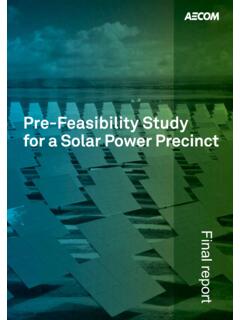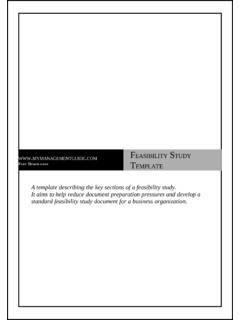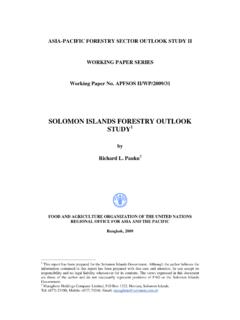Transcription of Solar Power Plant Pre-feasibility Study
1 Solar Power Plant Pre-feasibility Study 2 September 2008. ActewAGL and ACT Government Parsons Brinckerhoff Australia Pty Limited ABN 80 078 004 798. Level 4, Northbank Plaza 69 Ann Street Brisbane QLD 4000. GPO Box 2907. Brisbane QLD 4001. Australia Telephone +61 7 3854 6200. Facsimile +61 7 3854 6500. Email NCSI Certified Quality System ISO 9001. 2158583A-RPT001-Qbhpc f Solar Power Plant Pre-feasibility Study Contents Page Number Glossary ..iv executive summary ..vi 1. Introduction ..1. Background 1. Solar energy use for electric Power generation 1. Approach to this Study 2. 2. Key Study assumptions ..3. General 3. Project size 3. Project location 3. Assumptions and financial modelling 4. 3. Solar generation technology options ..5. General 5. Solar photovoltaic (PV) options 5. Fixed flat panel PV 5. Tracking flat panel PV 5. Concentrating photovoltaic (CPV) 6. Comparison of PV options 6. Solar thermal options 6. Lower temperature Solar thermal systems 7.
2 Concentrating Solar thermal (CST) Power systems 7. Comparison of Solar thermal options 10. Energy storage, auxiliary fuel and the performance of Solar generation 11. Role of energy storage 11. Heat storage for Solar thermal 11. Plant performance 11. 4. Solar energy Nature and use of Solar radiation 13. Solar resource in Canberra 14. Solar resource at other locations 15. Reliability and measurement of Solar radiation 16. 5. Solar generation Plant at Canberra ..17. Selection of appropriate technology 17. Overview of the ACT Solar Plant 18. Operation of the ACT Solar Plant 20. Energy storage and auxiliary fuel 21. Cogeneration and the additional energy 22. Cost 23. Capital cost 23. Operating and maintenance cost 24. Development schedule 24. Staged development option 25. Size of the Solar Plant 26. Future expansion of the Solar Plant 26. Land required 26. Potential suppliers of ACT CST Plant 27. Distributed generation compared with the Solar Plant 27.
3 Technologies already proposed for the ACT Solar Plant 27. 6. Location for the ACT Solar Plant ..28. Selection criteria 28. PB 2158583A-RPT001-Qpc Final Page i Solar Power Plant Pre-feasibility Study Contents (continued). Page Number Site identification methodology 28. 7. Electrical connection to the network ..29. General 29. Network connection 29. Cost 30. Metering 30. 8. Services and infrastructure ..31. General 31. Water 31. Gas 31. Roads and access 31. 9. Environmental, planning and carbon trading Environmental 32. Planning and approvals 32. Carbon trading 32. Broader sustainability issues 33. 10. Electricity sales and General 34. Renewable energy/green Power 34. 11. Government policy and support ..35. Australian Government policy 35. ACT Government policy 35. Other policy 35. Government support 35. General 35. Australian Government support 36. Expanded renewable energy target 36. Energy innovation fund 36. Accessing Australian Government support 37.
4 ACT Government support 37. 12. Risk assessment ..38. 13. Project evaluation ..41. Key inputs to modelling 41. summary of modelling 41. Results of Solar technology comparison 42. Further cost analysis of selected Solar farm option 42. Effect of size 43. Other locations 44. Other renewable energy projects in the ACT 44. 14. Conclusions and recommendations ..46. Conclusions 46. Recommendations 48. PB 2158583A-RPT001-Qpc Final Page ii Solar Power Plant Pre-feasibility Study Contents (continued). Page Number List of tables Table 2-1: Evaluation assumptions 4. Table 3-1: Comparison of PV options 6. Table 3-2: Major Solar thermal projects and programs 10. Table 5-1: Solar Power generation options for the ACT Plant 17. Table 5-2: Options for generating steam 22. Table 5-3: Development pathway 26. Table 12-1: Risk assessment 39. Table 13-1: Plant and infrastructure cost and details 41. Table 13-2: Results of modelling options 42. Table 13-3: Sensitivity analysis inputs 43.
5 Table 13-4: Results of sensitivity analysis 43. Table 13-5: Other renewable energy resources for the ACT 45. List of figures Figure 4-1: Solar radiation in Canberra 14. Figure 4-2: Monthly Solar radiation in Canberra 14. Figure 4-3: Hourly Solar radiation in Canberra 15. Figure 4-4: Solar radiation at other locations (annual) 15. Figure 5-1: Illustration of Nevada Solar One 18. Figure 5-2: Process diagram of trough Plant 18. Figure 5-3: Trough collectors 19. Figure 5-4: Partially stowed trough reflector 20. Figure 5-5: Trough reflector cleaning at SEGS 21. Figure 5-6: Development schedule 25. Figure 7-1: Cost of network connection studies and design 30. Figure 8-1: Solar Power station water use 31. List of appendices Appendix A - Photovoltaic Options Appendix B - CST Cost and Performance Appendix C - Solar Insulation Appendix D - Network Connections Appendix E - Planning Approvals PB 2158583A-RPT001-Qpc Final Page iii ACT Solar Farm Pre-feasibility Study Glossary ACT Australian Capital Territory ActewAGL is the ACT based multi utility offering electricity, natural gas, water and waste water ActewAGL.
6 Services in the area. It is the largest supplier of energy in the ACT. Annual capacity factor (actual energy production in MWh/a as a fraction of nameplate energy ACF. production). AETS Australian Emissions Trading Scheme CCGT Combined Cycle Gas Turbine CER Certified Emission Reduction CDM Clean Development Mechanism CPV Concentrating photovoltaic (PV). CST Concentrating Solar thermal DA Development approval DCF Discounted cash flow DNSP Distribution Network Service Provider EUA European Union Allocation (of carbon credits ). GWh Gigawatt hours GWh/a Gigawatt hours per annum of electricity production (109 watt hours). ha hectares (land area). HRSG Heat Recovery Steam Generator kWh kilowatt hours kV Kilovolt MRET Mandatory Renewable Energy Target IRR Internal Rate of Return MW Megawatts (capacity). MW (e) Megawatts (electric). MWh/a Megawatt hours per annum NEMMCO National Electricity Market Management Company NGAP National Green Energy Accreditation Program NPV Net Present Value O&M Operating and maintenance (cost).
7 PB Parsons Brinckerhoff REC Renewable Energy Certificate PV Photovoltaic PB 2158583A-RPT001-Qpc Final Page iv ACT Solar Farm Pre-feasibility Study SEGS Solar Energy Generating Systems WACC Weighted Average Cost of Capital PB 2158583A-RPT001-Qpc Final Page v ACT Solar Farm Pre-feasibility Study executive summary This Solar Power Plant Pre-feasibility Study was undertaken for ActewAGL and the ACT Government (the joint parties) by PB. Its purpose was to investigate Solar Power generation technologies, identify an appropriate Solar technology for the ACT, and establish the economic viability of a Solar Power facility. Technology for producing electricity from Solar energy is technically proven for both PV and Solar thermal technologies. 354 MW Solar thermal plants, using trough technology, have been operating in the USA since the 1980s and new plants of this type (between 50 MW and 70 MW) are now coming into service in the USA and Europe. Other Solar thermal technologies that are not yet in commercial use are Power towers, paraboidal dishes and Fresnel systems.
8 Large multi-megawatt PV plants, to approximately 50 MW, are now in operation. Solar technology is expensive, and significant financial assistance from government is available to the developers and operators of new plants. There is significant local community and market support for Solar Power generation. This Study identifies a 22 MW project that uses Solar thermal trough technology, similar to new overseas plants, as the best option for the ACT. This technology has been chosen because of its substantial operational record (more than 20 years), lower cost compared to other Solar technologies, and use in new commercial plants in the USA and Europe. The Plant will produce enough electricity for approximately 10,000 Canberra homes and the project cost, before government assistance, is estimated at $141 million (including land and infrastructure). A site of 120 ha will be required and if engineering, planning and environmental work commenced immediately, it is envisaged that a Plant could be commissioned by 2012.
9 An alternative option is a large PV cell-based Plant . To produce the same amount of electricity (that is, to service 10,000 homes), 75 ha of land would be required and the Plant would have an electrical capacity of 57 MW. This would be one of the largest PV plants in the world but the risks would be lower than the Solar thermal Plant , reflecting the more mature status of PV technology, its predictable performance and cost. However, the total project cost of $424 million is high. It is recommended that this Pre-feasibility Study be followed by a feasibility Study that includes engineering studies, ongoing commercial evaluation, financial modelling and environmental and planning studies. A staged Study , extending over eighteen months, could be conducted and lead directly into procurement and construction. However, trough technology is not cost effective for a staged development at the size of the proposed ACT Plant . Even though the Solar field is modular, the balance of the Plant is not suitable for staged development without incurring significant additional costs.
10 A financial evaluation of the Solar thermal project, assuming 100% equity funding, a Weighted Average Cost of Capital (WACC) and a 20-year project life was undertaken, Key results were: a levelised electricity cost of $106/MWh for a net project cost of $47 million. This is for a Plant cost of $2,500/kW, which is forecast for the technology in Australa, and allows grant funding of 50% of the project capital cost;. the relatively high cost of generation is due to the high capital cost of Plant itself, the high proportion of infrastructure and land (38% of project cost) and the relatively low productivity (measured by the 42%. capacity factor). PB 2158583A-RPT001-Qpc Final Page vi ACT Solar Farm Pre-feasibility Study larger Plant size would significantly improve the economics by spreading the infrastructure costs over a larger productive Plant and capturing economies of scale of the production Plant itself. For example, doubling the Plant to 44 MW would lower electricity cost by about 25%.









